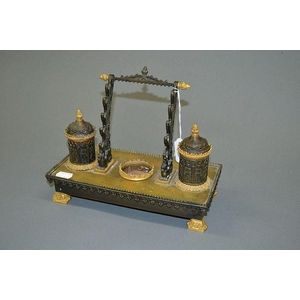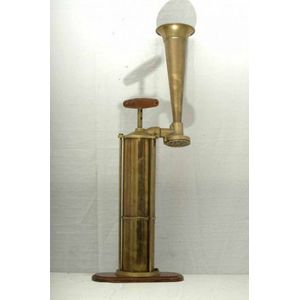Empire Style Bronze Mounted Marble Pedestal
You must be a subscriber, and be logged in to view price and dealer details.
Subscribe Now to view actual auction price for this item
When you subscribe, you have the option of setting the currency in which to display prices to $Au, $US, $NZ or Stg.
- Patera - A small decorative device, used as ornament in Neo-classical style furniture. Patera (or paterae) are usually round or oval, in the form of stylized rosettes. In the best pieces they are carved directly into the timber, otherwise they applied to the surface. Sometimes painted or inlaid motifs in the style are referred to as patera. Also known as a boss or a rosette.
- Bronze - An alloy of copper and tin, traditionally in the proportions of about 9 parts of copper to 1 part of tin.
The discovery of bronze in Western Asia in the 4th century enabled people to create metal objects which were superior to those previoulsy possible because of its strength and hardness, and it has been used throughout the world for weapons, coins, tools, statuary and other decorative items.
It is very fluid in a molten state, and its hardness, strength when set, and non-corrosive properties makes it most suitable for casting sculpture. - Gadrooning - A series of lobes usually as a border. In furniture gadrooning is found as carved decoration around the edges of table tops in the Chippendale and Jacobean style furniture. Gadrooning is also found as decoration on the rims of silver and ceramics.
- Provenance - A term used to describe the provable history of an antique or work of art, and thus an additional aid to verifying its authenticity. Provenance can have an inflating effect on the price of an item, particularly if the provenance relates to the early settlement of Australia, a famous person, or royalty. Less significant are previous sales of the item through an auction house or dealer.
- Paw Feet - A paw foot is a base of a furniture leg that resembles the paw of an animal, such as a lion or bear. It is a decorative feature that is often seen in traditional furniture designs, particularly in styles such as Chippendale, Queen Anne, and Georgian. A paw foot typically consists of a carved or moulded ball or disk at the bottom of the leg, which is then carved or shaped to resemble the toes or claws of an animal. The foot may be smooth or textured, depending on the design, and may be finished in a variety of materials, such as wood, metal, or even marble.
Paw feet are often used on heavier pieces of furniture, such as chests, tables, and chairs, to provide additional stability and support. They are also used as a decorative element, adding a touch of elegance and sophistication to the overall design.
"Hairy paw feet" is a term used to describe a variation of the foot design that features a carved or sculpted animal paw, such as a lion or bear, with hair or fur details. The hair or fur details were often carved in a realistic manner and added to the overall decorative effect of the furniture. Hairy paw feet were commonly found on furniture items such as tables, chairs, and cabinets and were popular in the 18th century. - Empire Style - The Empire style was a version of neo-classicism popular from 1800 to 1830, coinciding with the rule of Napoleon I from 1840-15. In England the style corrosponds with the Regency style and in the United States to the Federal style.
The style is inspired by classical Rome and Greece, as reflected in the decorative motifs in the the design such as paterae, guilloches, acanthus and swags, and pieces are lavishly decorated with applied gilded decoration. - Anthemion - An anthemion is a classical decorative design element based on the acanthus flower that consists of a central circular or oval motif surrounded by radiating petals or leaves. It is often used as a border or frieze in architecture, furniture, and other decorative arts. The anthemion is derived from the palmette, a motif that was popular in ancient Greek and Roman art and architecture. It is often associated with the classical world and with Neoclassical style, and it is often used to add a sense of grandeur and formality to a design. The anthemion is also known as a honeysuckle or honeysuckle ornament. It continues to be used in a variety of contexts today, and it is often admired for its elegant and decorative qualities.
- Frieze - An architectural term denoting the flat, shaped or convex horizontal surface of furniture, between the architrave and the cornice, usually found on a cabinet or bookcase, or on desks and tables where it may include drawers, the area between the top and the legs. In ceramics, the term refers to the banding, of usually a repeating pattern, on the rims of plates and vases.
- Mounts - Mounts are used to describe bronze, brass and ormolu adornments on furniture especially quality furniture in the rococo and classical revival style, and are also the cabinet makers' name for the metal fittings on furniture, such as hinges, locks and handles, and metal edges and guards which protect furniture from damage.
This item has been included into following indexes:
Visually similar items

Antique French bronze ink stand, fitted with cast bronze pots and multi quill holder

An Indian ivory pocket watch stand, 19th century. 29 cm

A brass ships Tyfon Foghorn manufactured Sweden with makers plaque height 78 cm

A pair French neoclassical style Candelabras, each candelabra depicts a bronze-metal figure supporting an upper five branch gilt-metal candelabra. Mounted upon a marble base. Height 68.5 cm
